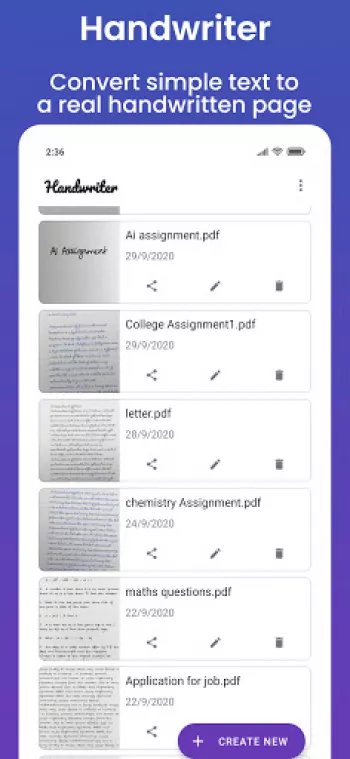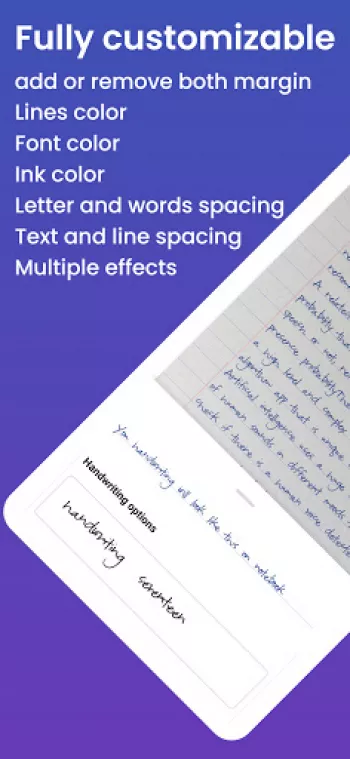Apps Home

Handwriter: text to assignment
The Evolution of Handwriting Recognition Technology
Handwriting recognition technology has evolved significantly over the past few decades, driven by advancements in machine learning and artificial intelligence. Initially, the challenge was to accurately interpret handwritten inputs into digital text due to the vast array of handwriting styles and scripts. Early systems relied heavily on rule-based algorithms, which required meticulous programming of numerous conditions to recognize different characters. However, these systems were often rigid and struggled with cursive writing or unique personal styles. The introduction of optical character recognition (OCR) marked a crucial turning point. OCR systems use scanners to digitize printed texts and images, thereby creating a foundation for later developments in handwriting recognition. The shift towards deep learning and neural networks has further revolutionized this field. Neural networks, in particular, mimic the functioning of the human brain and can improve their understanding of handwriting styles through iterative training on extensive handwriting datasets. This adaptability allows them to accurately convert various handwriting styles into digital text with high precision. Moreover, the integration of natural language processing (NLP) enables these systems to predict and auto-correct texts based on contextual understanding. These technological leaps have significant implications across multiple domains. For instance, they facilitate digital archiving of handwritten historical documents, making them accessible for scholarly work. In healthcare, they improve the digitization of prescriptions and medical records, minimizing human errors associated with manual transcription. As these technologies continue to develop, the potential for more accurate, efficient, and user-friendly handwriting recognition systems increases, ensuring a seamless transition from physical writing to digital text.
Features and Functionalities of Handwriting to Digital Text Apps
Handwriting to digital text applications are becoming increasingly sophisticated, offering a range of features that cater to different user needs. One of the key attributes of these apps is customization, enabling users to adjust settings like page margins, font styles, and text spacing to suit their preferences. Advanced customization options might include changing the line and ink color or adding effects such as shadows and smart rotations, which enhance the aesthetic appeal and realism of the converted text. Additionally, an increasing number of apps now allow the import and use of custom fonts, providing users with virtually limitless styling options. Beyond customization, these applications are integrating smarter algorithms designed to enhance the accuracy of handwriting recognition. AI-driven solutions can now intelligently decipher complex scripts, even adapting in real time to the user's particular handwriting nuances through self-learning mechanisms. Furthermore, unique effects like scanner and shadow effects offer users the ability to give their digital copies a more authentic look, emulating the imperfections of real handwriting. A noteworthy feature is the live editor, which displays changes immediately as they are made, facilitating an efficient editing process and reducing the time spent on manual adjustments. Not only do these apps cater to individuals looking to convert their notes, but they also address the needs of students, professionals, and researchers by providing a reliable tool for digitizing assignments, essays, letters, and more. As these applications evolve, they are gradually integrating with cloud services, allowing users to store, share, and access their documents from anywhere, thereby enhancing productivity and facilitating seamless collaboration.
Practical Applications of Handwriting Conversion Technology
The practical applications of handwriting conversion technology span across various fields, offering numerous advantages for both individuals and organizations. One of the key areas where this technology proves invaluable is education. Students can convert their handwritten notes into digital formats effortlessly, enabling easy sharing with peers or instructors and significantly simplifying the process of creating study materials or research reports. For educators, the technology streamlines the assessment process by facilitating the grading and archiving of assignments. In the corporate sector, professionals benefit from the ability to digitize meeting notes, brainstorming sessions, and project plans, ensuring that no valuable information is lost and making it easier to reference or revise ideas. Another growing application is in the medical industry, where accurate transcription of doctors' notes can lead to improved patient records management and reduced clerical errors, which ultimately enhance patient care. Similarly, in legal services, digitizing handwritten court documents and lawyer notes allows for better case management and more efficient legal research. Moreover, organizations involved in historical and cultural document preservation use handwriting conversion to make ancient manuscripts and texts more accessible for study and analysis. This digitization enables researchers worldwide to access rare documents without geographical constraints. These applications underscore the versatility of handwriting conversion technology, which continues to expand as more sectors recognize its benefits in improving productivity, accuracy, and accessibility. By automating complex transcription tasks, it allows professionals to focus on more strategic and creative aspects of their work.
Challenges and Future Prospects of Handwriting Recognition
Despite its promising advancements, handwriting recognition technology still faces several challenges that need to be addressed to achieve widespread adoption and effectiveness. One significant hurdle is the diversity of handwriting styles, which can vary dramatically not only between individuals but also across cultures and languages. This variety presents a challenge for the development of universally accurate handwriting recognition systems. Additionally, the technology must constantly adapt to different scripts, whether they are cursive or printed, as well as right-to-left scripts such as Arabic. Another challenge lies in the technology's sensitivity to input quality. Variations in penmanship due to factors such as writing speed or tool, surface irregularities, and even paper type can affect accuracy. Furthermore, integrating handwriting recognition with existing software systems and ensuring data security and privacy are crucial considerations for developers, especially when handling sensitive information. Despite these challenges, the future of handwriting recognition looks promising due to sustained technological innovations. Advances in AI, machine learning, and NLP continue to improve the accuracy, versatility, and speed of these systems. Combining handwriting recognition with voice and image recognition technologies could result in even more comprehensive and intuitive user interfaces. Such developments could further expand the technology's application in fields such as augmented reality and virtual collaboration platforms. Moreover, the growing interest in personalized and adaptive learning experiences in education could drive the integration of more interactive handwriting recognition solutions, offering students tailored feedback and guidance. As the technology matures, the potential for more sophisticated and seamless applications remains vast.
Exploring Handwriter App and Its Unique Features
The Handwriter app exemplifies modern handwriting conversion technology by offering users a suite of features designed to create convincing digital reproductions of handwritten text. As an app that effortlessly converts digital text from various sources, including internet articles, messages, eBooks, and PDFs, into a handwritten format, Handwriter provides both functionality and flexibility. Users can customize their outputs to suit different preferences, from altering margins and choosing from 53 free fonts to adjusting spacing between letters and words. The app allows for the addition of unique effects like smart rotation, scanner, and shadow that lend digital text a lifelike quality. Importantly, users are not confined to the fonts provided; they can upload their fonts for a truly personalized touch. Handwriter stands out for its user-friendly interface that promotes fast and efficient editing. Live previews ensure users can see changes instantly, saving time and enhancing creativity. The app also offers practical features for academic and professional use, such as the ability to save and share completed pages in PDF format, making it an invaluable tool for students completing large assignments swiftly or professionals needing to digitize notes and letters. Lastly, Handwriter's commitment to continuous improvement and expansion of its font library, with future updates promising more free fonts, ensures it remains a valuable resource. Users interested in trying Handwriter can Download for Android, further expanding the app's accessibility and versatility.
Share Your Opinion
Your Email Will Not Be Published.
All Rights Reserved © Apps Home 2025
































Brenda Brunner
I love this app, except for 1 thing.. I use my Galaxy Tab S6 to write lots of letters. I want to be able to save the parts of my letter that are al...
Briel 1020
I'd say this app is amazing, it is an app to write. It lets you choose letters and it's basically just that. I'd say it's an amazing app but it nee...
Rajen Ruidas
The HandWriter app by AndroXus is an excellent tool for converting digital text into realistic handwritten notes, making it perfect for students, p...
Shreyas Sen
Superb app man. I didnt expect that u ppl gave attention to small details like tilting the page a little bit(to show manual error), different shado...
Qayam Khan
Handwriter is a game-changer for those who are in school and putting efforts on compliting notes and projects . With its realistic and customizable...